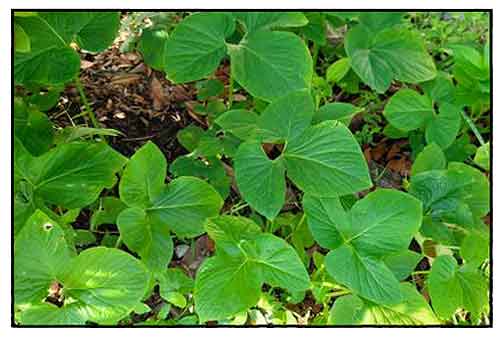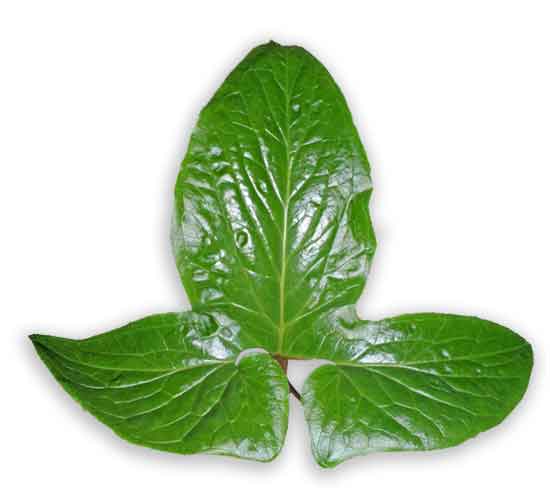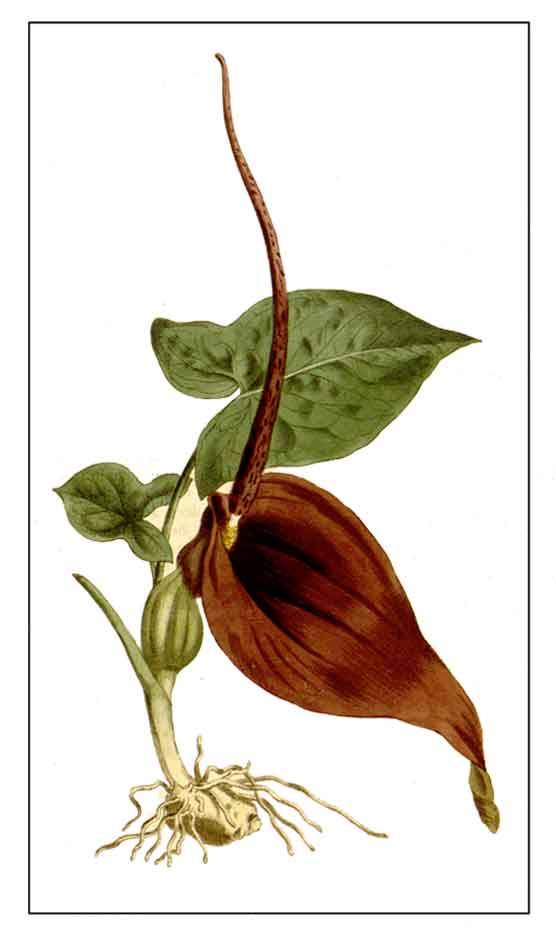 Gen info Gen info
- The genus Typhonium from the family Araceae comprises about 69 species of tuberous perennial herbs.
Botany
• Typhonium trilobatum is a small herb up to 45 cm tall, with subglobose corm up to 4 cm in diameter and roots from the top. Leaves with petiole up to 40 cm long, blade usually deeply trilobed, central lobe up to 20 cm × 10 cm, lateral lobes slightly smaller. Inflorescence a spadix; peduncle 5 cm long; spathe 10-20 cm, with dark red limb; spadix with 1 cm pistillate part, sterile part 1-2 cm long and covered with whitish intertwined filamentous sterile flowers, naked interstice 1-2.5 cm, staminate part 2-3 cm long, appendix 5-10 cm long and dark red. (3)
 • Underground part a short, tuberous rhizome, subglobose or subcylindric, producing few annual offsets or splitting up. Petiole green or variously flushed with purple, 25-40 cm; leaf blade cordate-ovate in outline, usually deeply 3-lobed, rarely 5-lobed; central lobe ovate, 10-15 × 6-11 cm, acuminate, sometimes mucronate; lateral lobes 8-13 cm. Inflorescence appearing after leaves; peduncle 5-10 cm, elongating in fruit. Spathe convolute at base, outside green, inside green, to 30 cm, ovoid or ellipsoid, 2.5-3.5 × 1-1.5 cm, constricted at apex; limb spreading, outside green, inside dark purple to reddish purple, ovate-lanceolate, ca. 15 × 5-8 cm, apex acuminate. Spadix shorter than spathe; female zone slightly conic, 7-10 mm; ovary yellowish green; stigma sessile, dark or mid-purple, disciform; sterile zone 2-3 cm, proximal half densely covered with staminodes, distal half naked; staminodes strongly curled but mostly directed downward and covering most of female zone, filiform, 7-12 mm; male zone 1.5-2 cm; stamens pink; appendix shortly stipitate, glossy purple or reddish, narrowly conic, 5-12 cm × 4-7 mm, base truncate, apex acute or subacute. Fruiting zone with spathe remaining; berries at first green with purple spots, white when mature, ellipsoid, 1- or 2-seeded. (Flora of China) • Underground part a short, tuberous rhizome, subglobose or subcylindric, producing few annual offsets or splitting up. Petiole green or variously flushed with purple, 25-40 cm; leaf blade cordate-ovate in outline, usually deeply 3-lobed, rarely 5-lobed; central lobe ovate, 10-15 × 6-11 cm, acuminate, sometimes mucronate; lateral lobes 8-13 cm. Inflorescence appearing after leaves; peduncle 5-10 cm, elongating in fruit. Spathe convolute at base, outside green, inside green, to 30 cm, ovoid or ellipsoid, 2.5-3.5 × 1-1.5 cm, constricted at apex; limb spreading, outside green, inside dark purple to reddish purple, ovate-lanceolate, ca. 15 × 5-8 cm, apex acuminate. Spadix shorter than spathe; female zone slightly conic, 7-10 mm; ovary yellowish green; stigma sessile, dark or mid-purple, disciform; sterile zone 2-3 cm, proximal half densely covered with staminodes, distal half naked; staminodes strongly curled but mostly directed downward and covering most of female zone, filiform, 7-12 mm; male zone 1.5-2 cm; stamens pink; appendix shortly stipitate, glossy purple or reddish, narrowly conic, 5-12 cm × 4-7 mm, base truncate, apex acute or subacute. Fruiting zone with spathe remaining; berries at first green with purple spots, white when mature, ellipsoid, 1- or 2-seeded. (Flora of China)
 Distribution Distribution
- Introduced.
- Laguna in Luzon, Lanao del Norte in Mindanao. (2)
-
Naturalized in grasslands and semi-open forests in Lanao del Norte and in rice fields.
- Native to
Assam, Bangladesh, Cambodia, China, Hainan, India, Laos, Malaya, Myanmar, Nepal, Sri Lanka, Thailand, Vietnam. (1)
- A tuberous geophyte that grows primarily in the wet tropical biome. (1)
Constituents
- Preliminary screening of ethanolic leaf extract yielded reducing sugars, alkaloids, flavonoids, tannins, steroids, gums, and glycosides. (see study below) (4)
- Preliminary phytochemical screening of crude extracts of tubers
yielded flavonoids, carbohydrates, phenols, and alkaloids. Ethanol extract yielded flavonoids, while the methanol extract showed high concentration of carbohydrates. Chloroform extract showed moderate presence of phenols and alkaloids. No tannins, steroids, or saponins were detected. (9)
- Ethyl acetate fraction of methanol extract of leaves yielded alkaloids, gums, flavonoids, steroids and terpenoids, with absence of glycosides, reducing sugars, tannins, and saponins. (see study below) (11)
- Nutrient content analysis revealed: moisture 88.84%, carbohydrate 2.94 gm%, lipid 0.66 gm, total ash 1.30 gm%; proximate composition: protein 2.81 gm, crude fiber 2.44gm, vitamin C 108.08 mg%; minerals: sodium 0.03 mg, potassium 5.23 mg, calcium 22.59 mg, iron 58.40 mg;
antinutritionals: phytate 0.35 µg, oxalate 7.19 mg. (21)
- Study for phytochemical contents (mg/gm extract) yielded total polyphenols 21.18, total flavonoids 11.25, total hydrolysable tannins 22.17. (21)
Properties
- Studies have suggested anti-inflammatory, analgesic, anti-diarrheal, antioxidant, thrombolytic, membrane stabilizing, antispasmodic, anti-depressant, wound healing, antidiabetic, cholinesterase inhibitory properties.
Toxicity
• Report on T. trilobatum Poisoning in Humans: Study reports on a toxidrome of airway compromise due to Typhonium trilobatum ingestion. Four patients presented with a constellation of symptoms after consuming raw tubers, with swelling of lips and tongue, salivary drooling, and severe throat pain. One patient had significant upper airway edema and severe respiratory distress requiring emergency endotracheal intubation. Patients were successfully managed with repeated adrenaline nebulization, antihistamines, and steroids. Symptoms were attributed to local effects of calcium oxalate crystals in the tuber. Airway management is priority, along with repeated adrenaliine nebulization and supportive care. (13)
Parts used
Tubers, leaves.
 Uses Uses
Edibility
- Dried sliced corms are eaten in Indo-China. (see toxicity above)
- Leaves used as vegetable. (22)
Folkloric
- No reported medicinal use in the Philippines.
-
In Thailand, tubers are applied to wounds and for abdominal rigidity. Heated and soften leaves used as poultice for boils. In Vietnam, decoction of tubers used to treat cough, asthma, nausea, headache, gastric ulcers, abscesses, snakebites, and to stop vomiting. (3)
- Rhizome used for skin eruptions, gastric ulcer, asthma, headache, lymph tuberculosis, chronic bronchitis, vomiting, cough, rheumatism, abscess, snake bites, diarrhea and dysentery. Leaves and tubers cooked as vegetables and given to patients suffering from piles and rheumatism. (4)
- In West Bengal, India, herb used by tribals against lymphatic filariasis.
- In Tripura, India, Mog communities use paste of root for sore throat. (18) Leaves used for treatment of jaundice. (22)
- In Bangladesh, leaf juice is taken for mucus; crushed leaves taken for loss of appetite. (19)
- In Ayurveda and Unani medicine, rhizome has been used for treatment of vomiting, cough, asthma, excessive expectoration, pyrogenic sore throat, headache, gastric ulcer, abscess, snakebites, diarrhea and dysentery, stimulant and menstrual problems. (21)
Others
- Fish food: Leaves used as fish food.
- Veterinary: Acrid tubers applied in poultices as counter-irritant; also to destroy maggots in sores on cattle. (20)
Studies
• Analgesic / Anti-Inflammatory / Antidiarrheal / Leaves: Study evaluated the analgesic, anti-inflammatory, and anti-diarrheal activities of ethanolic leaf extract of T. trilobatum. Extract showed significant inhibition of writhing (p<0.01), significant inhibition of xylene-induced ear edema (p<0.05) and significant decrease in frequency of defecation and increase in mean latent period (p<0.01) in castor oil-induced diarrheal model in mice at doses of 250 and 500 mg/kbw. (4)
• Acute Toxicity Test / Leaves: Mice given 800 mg/kg of ethanolic leaf extract resulted in no mortality in 48 h of assessment, suggesting minimum lethal dose is more than 800 mg/kg. (4)
• Wound Healing: Study evaluated the wound healing activity of various extracts of T. trilobatum using excision and incision models. Results showed significant wound healing activity. A methanolic and ethyl acetate extract showed greater wound healing activity than a chloroform extract in measures of breaking strength in the incision model and percentage wound contraction, period of epithelization in the excision model. (5)
• Antioxidant / Roots: Study evaluated a root extract of T. trilobatum for phytochemical screening, invitro antioxidant, thrombolytic, membrane stabilizing, antidepressant activities and acute toxicity. Phytochemical screening revealed presence of phenols, flavonoids, and carbohydrates Invitro antioxidant testing showed scavenging capacity. Root extracts showed good membrane stabilizing capacity, mild antidepressant activity, but no thrombolytic activity. (6)
• Antioxidant / Thrombolytic / Membrane Stabilizing / Antidepressant / Antispasmodic / Leaves: Study a crude extract for phytoconstituents and pharmacologic activities. Phytochemical screening of various plant parts yielded flavonoids, phenols, and alkaloids, with significant amounts of flavonoid and phenolic contents in the ethanolic leaf extract. Leaf extracts showed good potential for antioxidant activity by six different assays. There was significant thrombolytic effect (p<0.05) and good human RBC membrane stabilizing effect with the % clot lysis of 30.15% and 22.64% with methanol and chloroform leaf extracts. Chloroform extract at 100 and 200 mg/kg showed very significant (p<0.01) effect on GI motility. All leaf extracts at 100 and 200 mg/kg demonstrated very potent dose-dependent anti-depressant effect. (7)
• Larvicidal / Target Specific / Cx quinquefasciatus / Leaves: Study evaluated the target specific larvicidal potential of crude and methanol extracts of mature leaves of T. trilobatum against mosquito Culex quinquefasciatus. Results showed 100% mortality of 1st instar mosquito larvae at 0.4% concentration after 72 h exposure to the crude extract. At 72 h 0.5% concentration produced 100%, 89.99%, and 79.99% mortality of 2nd, 3rd, and 4th instar larvae, respectively. Secondary metabolites like terpenoids and free glycoside bound anthraquinones were found. Results suggest a potential valuable resource of effective target specific mosquito larvicide. (8)
• Analgesic / Cytotoxic / Leaf and Tuber: Study evaluated the analgesic activity of crude chloroform extra ct of root, shoot, and leaf, and petroleum ether fraction of leaves using acetic acid induced writhing method, formalin induced licking and hot plate test on Swiss albino mice at 200 and 400 mg/kbw. Extracts exhibited significant inhibition of writhing, licking, and heat tolerance compared to control. All types of extracts showed presence of cytotoxicity over brine shrimp, where vincristine sulfate was used as control. (10)
• Antidiabetic / Leaves: Study evaluated the antidiabetic activity of methanolic extracts of ethyl acetate and chloroform fraction of leaves of T. trilobatum using single dose and multi-dose treatment normoglycemic and diabetic Wister strain of albino rats. The ethyl acetate fraction showed higher anti-diabetic activity than the chloroform fraction. The effect may be due to stimulation of ß-cells in the pancreatic islets. (11)
• Antibacterial / Herbal Therapy against Pulmonary Diseases in Pigs and Man / Tuber: Study evaluated the efficacy of hydroethanolic tuber extract against respiratory bacterial pathogens isolated and identified from nasal swabs and tissue samples of patients and pigs suffering from respiratory illness. Hydro-ethanolic extracts of T. trilobatum showed significant antibacterial activity against the isolated bacterial flora. The antibacterial efficacy was attributed to the presence of three broad groups of compounds i.e., organic acids, monosaccharides and polyols detected by GC-MS. (12)
• Acetylcholinesterase Inhibitory / Antioxidant / Leaves and Stems: Alzheimer's disease is a progressive neurodegenerative disorder of elderly people. Typhonium trilobatum has been used in traditional folk medicine as a central nervous system stimulant. Study evaluated various extracts for acetylcholinesterase inhibitory and antioxidant activities. Petroleum ether extract exhibited highest inhibition with IC50 of 255.26 µg/ml. Al extracts showed antioxidant activity. In DPPH radical scavenging assay, the chloroform extract showed highest scavenging activity with IC50 of 619.54 µg/ml. The ethyl acetate extract showed highest amounts of flavonoids and the PE extract showed highest phenolics. Results showed antioxidant and cholinesterase inhibitory activity, which may be used in reducing risk of AD. (14)
• Inhibitory against Toxigenic Vibrio Cholera / Leaves: Study evaluated the antibacterial and antibiofilm activities of methanol extract of T. trilobatum leaves against strains of multi-drug resistant (MDR)serotypes of Vibrio cholerae, which are responsible for watery diarrhea such as cholera. METTL showed antibacterial activity with MIC and MBC at 1-32 mg/mL and 8-32 mg/mL, respectively, against clinical strains of V. cholera. METTL showed significant (p<0.05) inhibitory activity on formation of biofilm and also showed significant (p<0.05) inhibitory activity on the formation of extracellular polymeric substances (EPS) formation by V. cholerae SG24. METTL significantly (p<0.01) inhibited the Cholera toxin (CT) production by Cholera strains SG24. The active T. trilobatum leaves may have potential as a substitute for treatment of MDR V. cholera infection and as source of development of novel antimicrobial compound/s and biofilm-inhibitory drug/s for treatment of cholera and diarrheal patients. (15)
• Lectin / Antibacterial / Cytotoxicity / Rhizomes: Study isolated, identified, partially purified, and characterized purified lectin from T. trilobatum. Three lectins were present. Minimum concentration of Hemagglutination activity assay was 15.4 µg/ml. The Lectins showed slight toxicity towards brine shrimp nauplii, with LC50 of 9.90648, and slight antibacterial activity against E. coli (123 µg/disc and 184.8 µg/disc). (16)
• Antifilarial / Larvicidal: Study evaluated crude aqueous extract of T. trilobatum on microfilariae of Wuchereria bancrofti, adult of Setaria digitata, larvicidal effect on brine shrimp larvae and 4th instar larvae of Cx. quinquefasciatus. Results showed remarkable dose dependent inhibitory activity against W. bancrofti and S. digitata and significant inhibition of 4th instar larvae of Cx. quinquefasciatus. It showed no cytotoxic effect on brine shrimp. (17)
• Antioxidant Activity / Leaves: Study for antioxidant activity of leaves showed IC50 of 432.90 µg/ml DPPH radical scavenging activity and EC50 of 155.31 µg/ml ABTS radical scavenging activity. (21)
• Effect of Cooking on Antioxidant and Anti-Inflammatory Activity of Leaves: Large diversity in phytochemical content and antioxidant activity were found with temperature and time variation in comparison to unheated crude extract. Heating increase total phenolic and antioxidant, as well as anti-inflammatory capacity by liberation of phenolic compounds from their esterified or glycosylated bound form. On heating at high temperature, as in domestic frying at 150-180°C for 30 min the leaves showed highest polyphenol (194.86 mg GAE/DE, flavonoids 61,28 GAE/De, and tannin 46.77 GAE/DE) content. Results suggest domestic cooking at this temperature is optimum for maximum utilization of its antioxidant or disease preventing capacity. (23)
Availability
Wild-crafted.
|

![]()







